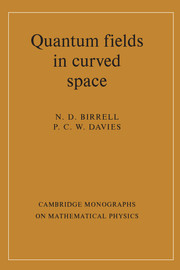Book contents
- Frontmatter
- Contents
- Preface
- Preface to the paperback edition
- Conventions and abbreviations
- 1 Introduction
- 2 Quantum field theory in Minkowski space
- 3 Quantum field theory in curved spacetime
- 4 Flat spacetime examples
- 5 Curved spacetime examples
- 6 Stress-tensor renormalization
- 7 Applications of renormalization techniques
- 8 Quantum black holes
- 9 Interacting fields
- References
- Index
4 - Flat spacetime examples
Published online by Cambridge University Press: 05 August 2012
- Frontmatter
- Contents
- Preface
- Preface to the paperback edition
- Conventions and abbreviations
- 1 Introduction
- 2 Quantum field theory in Minkowski space
- 3 Quantum field theory in curved spacetime
- 4 Flat spacetime examples
- 5 Curved spacetime examples
- 6 Stress-tensor renormalization
- 7 Applications of renormalization techniques
- 8 Quantum black holes
- 9 Interacting fields
- References
- Index
Summary
Having invested so much effort in mastering curved space quantum field theory, the reader may be dismayed to return to the topic of flat spacetime. Flat spacetime does not, however, imply Minkowski space quantum field theory.
We consider three main topics in which the general curved spacetime formalism must be applied to achieve sensible results, even though the geometry is flat. This enables some non-trivial geometrical effects to be explored within the considerable simplification afforded by a flat geometry. In particular, we are able to discuss 〈Tµν〉 in some special cases without employing the full theory of curved space regularization and renormalization to be developed in chapter 6.
The first case examines the effects of a non-trivial topology. We do not treat particle creation at this stage, but limit the discussion to 〈Tµν〉, which is nonzero even for the vacuum. This topic is one of the few in our subject which makes contact with laboratory physics, for the disturbance to the electromagnetic vacuum induced by the presence of two parallel conducting plates is actually observable. The force of attraction that appears is called the Casimir effect, and has been extensively discussed in the literature.
The treatment of boundary surfaces leads naturally to a very simple, yet extremely illuminating, system that is well worth studying in detail. This is the case of the ‘moving mirror’, in which a boundary at which the quantum field is constrained moves about.
Information
- Type
- Chapter
- Information
- Quantum Fields in Curved Space , pp. 89 - 117Publisher: Cambridge University PressPrint publication year: 1982
